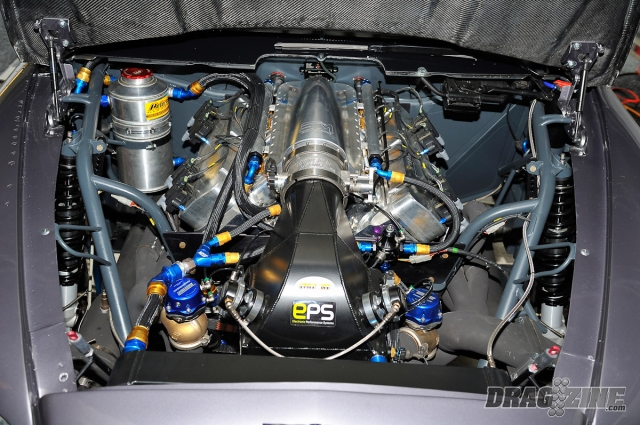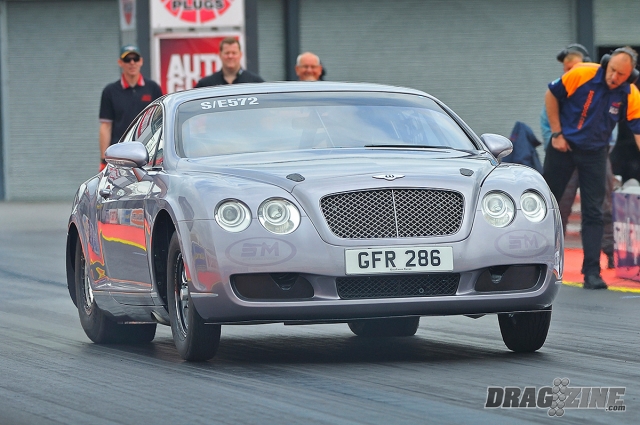Photos by Matt Woods Photography
In a sport that’s filled with show-quality race cars engineered to perfection right down to the finest of details, crafted by some of the most talented fabricators in the world, it’s no simple task — nor an affordable one— to produce something that truly stands out amongst the crowd. But every so often, we witness the unveiling of that one-in-a-million project that knocks it out of the park in every regard…inside and out. Where little expense is spared to carry out a creative vision to completion and deliver something to the racing world that it’s never laid eyes on before — and perhaps never imagined that it might see.
 Mere weeks ago, just such a machine — no, a work of art, rather — rolled out of the bay doors at Webster Race Engineering and rumbled through the streets of Wellingborough, England for the first time — like a young thoroughbred colt taking it’s first strides — brought a culmination to months of anticipation by not only those watching its construction from around the world, but from its proud new owner.
Mere weeks ago, just such a machine — no, a work of art, rather — rolled out of the bay doors at Webster Race Engineering and rumbled through the streets of Wellingborough, England for the first time — like a young thoroughbred colt taking it’s first strides — brought a culmination to months of anticipation by not only those watching its construction from around the world, but from its proud new owner.
Englishman Steven Niemantas has long had a penchant for incredibly fast street cars. A self-described Chrysler man, he began racing in 1987, and had counted a 1969 Plymouth GTX, a 1934 Ford with a 440 Chrysler, a 1966 Charger, a 1964 Polara, a 1968 GTX convertible, and other Chrysler vehicles among his many vehicles over the years. But most recently, he’d turned his focus to luxury automobiles, campaigning a 1998 Aston Martin Vantage, that featured a full tube chassis and a supercharged, 572 cubic inch Chrysler Wedge motor for power. Remarkably, it ran in the 7.70’s at nearly 180 miles per hour on slicks and 8.60’s at a buck-sixty on street tires.
Last fall, a plan was hatched to convert the sleek coupe to a blow-through carburetor combination paired with a ProCharger, but a number of conversations with the staff Steve Morris Engines in the United States swayed Niemantas in a new direction — one that would eventually completely blow away everyone who laid eyes on it.
…I later came to the conclusion that to convert the 572 in the Aston Martin to a turbocharger combination and change everything else on the car to accommodate it, it would be better to simply start with a clean sheet of paper and build a new car.
“Alex at Steve Morris Engines convinced me that twin turbos and electronic fuel injection was the way of the future. But I later came to the conclusion that to convert the 572 in the Aston Martin to a turbocharger combination and change everything else on the car to accommodate it, it would be better to simply start with a clean sheet of paper and build a new car,” said Niemantas.
From there, Niemantas began considering options for his lofty new project, and taking a page from the royal playbook, settled on an equally high-end luxury steed to join the Aston Martin: a 2004 Bentley Continental GT — a lavish grand tourer coupe far more fit for the streets of Beverley Hills or Abu Dhabi than a drag strip in the United Kingdom. But as Niemantas shared with us, the price was right, and although a German-owned company, the Bentley brand is, in his eyes, very much a British hallmark.
In late September, Niemantas was able to purchase the nearly ten-year old model, which was priced at just under $150,000 when new off the showroom floor, for just over $30,000 American dollars (or £19,000), and recouped nearly two-thirds of that expenditure by selling off the parts that he and chassis builder Jon Webster removed to begin the extensive project.
Said Niemeatas, “The Bentley was a nice running car when I bought it. I used it for a week then we chopped it up, sold all the parts and took the body to Jon.”
Niemantas tasked Webster and his team, who were the master craftsmen behind many of the UK’s finest racing machines, including Andy Frost’s record-setting Vauxhall, to construct a truly state-of-the-art piece capable of running with some of the quickest and fastest street cars in the world, all while retaining a very stock appearance. And, of course, it had to be a street car through-and-through.
(Left) Niemantas' 1998 Aston Martin Vantage, which has run well into the seven-second range. (Right) The Bentley Continental GT before going under the knife.
Webster and company spent nearly seven months building the car, beginning with the bare Continental GT shell. The steel body itself, the doors, and the trunk were all retained, and paired with a composite front end that’s a dead-ringer to the original, if you didn’t know any better.
“We tried to keep it looking as stock as possible,” said Niemantas. “Its a street car, and I didn’t want it to look like a race car. There are no scoops or bulges in the hood, and no big wings. We used the original side mirrors, door handles, hood and trunk hinges, sill plates and everything to keep it looking very stock.”
 Webster built a complete 25.2 spec chromoly chassis within the confines of the Bentley body, incorporating what he calls a semi-adjustable flex design. Strange Engineering GT struts were installed up front with custom WRE limiters, with Strange brakes, rack and pinion steering, and 14-inch, 250 lb. springs completing the package. Out back, a full four-link rear end was fabricated to hold the custom WRE nine-inch housing in place, which was fitted with Moser Engineering 35-spline internals, with a locker and 3.00 gears. A set of 11-inch brakes were sourced from Wilwood, while a pair of 19-inch, double-adjustable shocks with 14-inch, 250lb. springs from Strange handled the chore of compression and rebound to get the power to the ground.
Webster built a complete 25.2 spec chromoly chassis within the confines of the Bentley body, incorporating what he calls a semi-adjustable flex design. Strange Engineering GT struts were installed up front with custom WRE limiters, with Strange brakes, rack and pinion steering, and 14-inch, 250 lb. springs completing the package. Out back, a full four-link rear end was fabricated to hold the custom WRE nine-inch housing in place, which was fitted with Moser Engineering 35-spline internals, with a locker and 3.00 gears. A set of 11-inch brakes were sourced from Wilwood, while a pair of 19-inch, double-adjustable shocks with 14-inch, 250lb. springs from Strange handled the chore of compression and rebound to get the power to the ground.
While Webster and his team were hard at work on the chassis, nearly 4,500 miles away, well-regarded engine man Steve Morris was assembling the bullet that would power this impressive new project. With sights set on seven-second runs and perhaps even sub-seven seconds, Niemantas and Morris weren’t shy about the combination for the new car in the least, opting for a 615 cubic inch big block nearly identical to the one that powered Tom Bailey’s ‘Sick Seconds’ Camaro to victory at Drag Week a year ago. The only difference between the two, in this case, would be the use of smaller 88mm Bullseye billet turbochargers. Despite that, a healthy dose 2,500 to 3,000 horsepower was expected to be on tap.
Morris utilized a Brodix aluminum block and stuffed it with a 4.625-inch Callies crankshaft and Ultra I-beam connecting rods, custom Diamond pistons, and a custom in-house roller camshaft to complete the short block. A set of CNC-ported, 14.5-degree Sonnys/Brodix heads were added, as was a custom SME billet intake manifold. A number of other top-quality parts and pieces fill out the engine combo, including a Jesel belt drive setup and a Pro Series shaft rocker kit, Crower Endura-Max lifters, Trend Industries pushrods, an Innovators West balancer, and a laundry list of other components. Morris also added a five-stage dry sump oiling system with a Moroso pan and six-stage pump with a Peterson Fluid Systems tank to handle the oiling needs of such a potent package.
Webster fabricated the 2.25-inch turbo headers that fit neatly under the hood of the Bentley, with 4.5-inch side exit exhaust outlets. Turbosmart wastegates and blowoff valves handle the boost side of things. AEM coils controlled by MoTec Electronics installed by EPS Motorsports handle the ignition side of things, with Moran injectors tasked with delivering the fuel to the billet intake.
Niemantas tabbed Andy Frost to supply the Powerglide transmission for the project, which features a Reid Racing two-piece aftermarket case. The transmission features a host of billet internals, along with an Aerospace input shaft, billet drum, transbrake, a carbon metallic low band, and billet servo. The transmission has a 1.58 ratio first gear. Once complete, the ‘Glide was paired with a steel bolt together BBX torque converter from Neal Chance, and a B&M Street Bandit shifter handles the shifting duties from the cockpit.
 A WRE driveshaft, measuring 3.5-inches in diameter with 1350 U-joints, transfers the power back to the nine-inch housing to the Weld V Series double beadlock wheels (12 x 15”) wrapped in 315/60/15 Mickey Thompson Drag Radials. A set of V Series wheels are also present up front, measuring 3.5 x 15” with Mickey Thompson rubber.
A WRE driveshaft, measuring 3.5-inches in diameter with 1350 U-joints, transfers the power back to the nine-inch housing to the Weld V Series double beadlock wheels (12 x 15”) wrapped in 315/60/15 Mickey Thompson Drag Radials. A set of V Series wheels are also present up front, measuring 3.5 x 15” with Mickey Thompson rubber.
A liberal use of carbon fiber has been used in the car’s interior, including the seats, dash, transmission tunnel, wheel tubs, door bar protectors and door panels, making for what isn’t likely to be considered luxury to the average person, but certainly is to any racer.
Webster is handling the chassis tuning on the car, while David Rowe of EPS Motorsport is handling the fuel mapping on the engine combination.
Niemantas will enter the car in the Street Eliminator category at events in and around the UK — a class that requires the use of street tires and pump gas and institutes a 25-mile cruise after qualifying to prove road-worthiness. He plans to later slap a set of slicks and wheelie bars on the car, with hopes of mid to low-seven second passes on the radials and sixes on the slicks. The Bentley has only been to the track once thus far, making a best pass of 8.11 at 179 miles per hour before rain shortened the day and ended the maiden voyage before Niemantas could collect a seven-second time slip.
 Once the combination is lined out — and if funds permit — Niemantas has already indicated his desire to bring the immaculate machine to the United States for Drag Week, where it would no doubt be a welcome addition (or rather, the center of attention) to an already stacked field of street cars.
Once the combination is lined out — and if funds permit — Niemantas has already indicated his desire to bring the immaculate machine to the United States for Drag Week, where it would no doubt be a welcome addition (or rather, the center of attention) to an already stacked field of street cars.
I would love to go to Drag Week,” he said. “If the car car run into the sixes and does a lot of road miles reliably, then I`d like to do it, money permitting. It would be an honor to do it and race with the fastest cars in America. Here’s to hoping.”
When asked how he could possibly pick out a favorite aspect of his new jewel, Niemantas shared, “All of it really. It turned out just the way I hoped for…from 20 feet away it looks pretty stock. I’ve always liked the fast street cars and I wanted something that didn’t look like a race car on the road but a street car on the track.
“I’m extremely pleased with the car — it turned out just how I wanted. Jon Websters’ work is second to none, and Steve Morris’ engine is awesome. We just need some decent weather and track time to try and get some decent numbers. Then get some more road miles on it,” Niemantas said in closing.




































